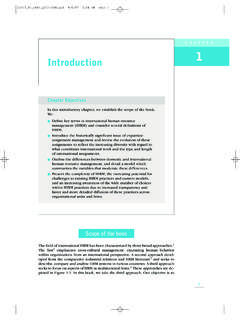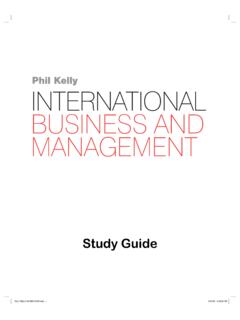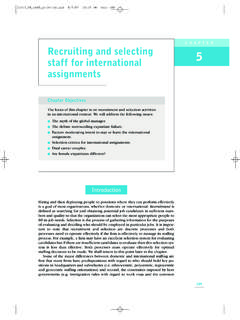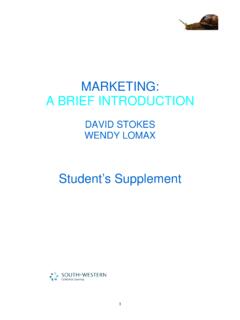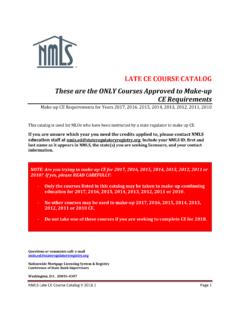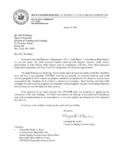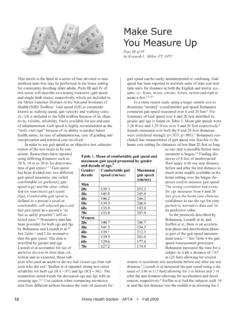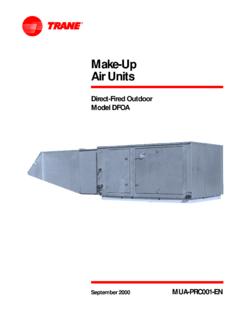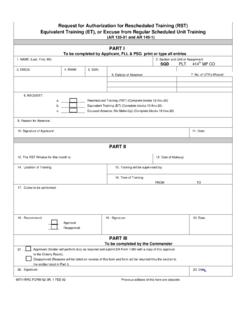Transcription of 2 Fashion and photographic make-up (B11)
1 O-122 Fashion and photographic make -up (B11)B11 Unit Learning ObjectivesThis chapter covers Unit B11 Fashion and photographic make -upThis unit is about developing your creative make -up skills for Fashion and photographic work in a way that enhances your professional profi le. The ability to research, plan and create a range of make -up looks to a given brief, in conjunc-tion with others is required in this unit. The ability to evalu-ate the results against the design plan is also carry out this unit you will need to maintain effective health, safety and hygiene practice throughout your work. You will also need to communicate the design concepts or ideas effectively with others involved in the B11 describes the competencies to enable you to: plan and design a range of make -up looks produce a range of make -up looks evaluate your results against the design assessor will observe your performance when creat-ing Fashion and photographic make -up looks on at least four separate the range, you must show that you have: produced looks for all the types of activities created all the types of looks I am a media and theatrical make -up artist and hair stylist specializing in Fashion and photographic make -up with 20 years of experience.
2 I attended a three-year hair and beauty therapy course, then gained a theatrical and media qualifi cation. I started out working as a hairdresser in salons part-time to fund my ever-growing kit and to help my career starting up as a media make -up artist. I joined a local model agency who helped me set up test shots to get my portfolio together and slowly gained paid work that way. I have done a lot of travelling, and have been lucky to work on amazing campaigns, editorials and worked with celebrities. I work closely with photographers on shoot briefs to present to clients to give a better understanding of a fi nal product. This can include gathering a mood board together of images and also a write-up of the connection between key points within the board. One of my career highlights was working with the designer Elizabeth Emanuel on her Archive Collection where I designed make -up and hair to fi t in with the styles of the gowns, to add to this I also made headdresses to add to the drama of the Perry-BevanMedia and theatrical make -up artist and hair stylist (self- employed)ROLE MODEL and hair stylist (continued on the next page)ANDREA PERRY-BEVANISTOCK: BTRENKELO-13 CHAPTER 2 (B11) Fashion AND photographic make -UPFashion and photographic make -upThe world of the Fashion and photographic make -up artist is an exciting and ever- changing one.
3 It is of the utmost importance to keep up-to-date with current Fashion and trends. What may be fashionable one season can change the next, and quickly look outdated. You can produce some looks which are classic and never really date, or design high- Fashion images which will look terrifi c on a professional model, but not as good on a member of the general public as a special occasion must work closely with the other people involved in the process so you all work towards, and aim for, the same agreed end result. Detailed and accurate planning is important so that no misunderstandings and subsequent waste of resources including time and must understand the subtle differences used in creating make -up looks for both colour and black and white photography and the effect distance and lighting has on Fashion shows. You will create a range of period-inspired looks and need to use your imagination and artistic skills to create fantasy and high- Fashion effects.
4 Commercial make -up is created for advertising purposes and must not detract from the subject/ medium being advertized, while bridal make -up must suit and please the individual wearing it, as well as looking great for photographic purposes. The stages for Fashion and photographic make -up activities will always be similar, although the techniques and fi nished effects can be quite different. Your work in this area will include make -up looks for photographic shoots, catwalk shows, music videos, commercials, bridal and special occasion make -ups. addressed all the resource needs involved at least two of the seven relevant persons* used all the make -up application techniques considered all of the additional media*.*Note: For these particular units, knowledge evidence need not be produced for the remaining items in the is likely that most evidence of your performance will be gathered from the observations made by your assessor, but you may be required to produce other evidence to support your performance if your assessor has not been designing and creating images for use in Fashion photographic contexts, it is important to use the skills you have learnt in the following core mandatory units:G22 Monitoring safe work operationsH32 Promotional activities(continued)Bridal make -upJO CROWDERO-14 LEVEL 3 PROFESSIONAL BEAUTY THERAPY If you are in a dingy corner without natural day-light, ask the photographer to set up some extra lights to illuminate your model s face while you are TIPHEALTH& SAFETY Recognize potential hazards in the workplace and warn other colleagues and clients of them.
5 Recognize steps that can be taken to minimize the risk of injury and infection at any make -up how and if legislation and local bye-laws will restrict or limit your use of products, tools and equipment where you are 1: Plan and design a range of make -up looksB11 Plan and design a range of make -up looks by:1 agreeing contractual arrangements with the relevant person(s) prior to commencing your design plan2 clearly identifying the intended activities for which the make -up is required 3 using suitable sources of information to research ideas on themes for design 4 accurately sourcing and using suitable information to create your design 5 creating a design plan which: has clearly defi ned objectives which meet the client s brief contains mood boards suitable for the look(s) required takes account of budgetary constraints defi nes all resources required states how any risks to health and safety can be reduced takes account of foreseeable problems and ways of resolving them takes account of lighting requirements takes account of additional media agreeing your design plan with the relevant person(s) Preparing the working environmentPreparing the working environmentMake sure you are prepared, have everything you could possibly need, and that your kit is clean and well organized.
6 When you arrive at the studio there may or may not be a designated area for make -up application. Most good studios have an area with seating and a make -up mirror; others can be less than ideal and you just have to make the most of what you have. make sure the area is safe, comfortable and clean before you lay out your equipment. At the end of a day, I always make sure that my kit is clean and ready for the next job, as you can easily have a last minute call out. Always arrive at a job looking presentable and Perry-BevanWhen you have fi nished your make -up, you will need to keep a few products on hand, such as powder and a powder puff, cotton buds, tissues and lip colour required to main-tain the make -up look. For changes of costume and make -up, you should be able to take your model back to the designated make -up on location you must make the most of the environment you are in. Try to keep make -up at a regular temperature, so it does not freeze or melt.
7 A cool bag is a good place to store your make -up. If working in windy conditions, make sure your make -up box has a lid, so it does not end up full of sand or leaves, dependant upon the location. Set bag, as used when fi lming (see Online Chapter 4 TV, fi lm and special effects make -up), is very useful when on location, when you need to fi nd products quickly. Some products can be decanted or transferred into plastic bottles, which can reduce breakages, especially on fl ights. Because of added security at airports and the ban on liquids in hand luggage, it is best to put make -up kits in the hold, just make sure your box/bag is sturdy enough to avoid 2 (B11) Fashion AND photographic make -UPMood boardJO CROWDERBEST PRACTICE make sure you agree all con-tractual arrangements prior to commencing the design plan. These must be realistic. Specify resource needs accurately and stay within your aware that the client may not have been on a shoot before.
8 Advise them about health and safety, and any potential danger areas in the studio or on location. Items such as trailing cables, light boxes, stands and refl ector boards are all hazards that you must look out for. You must be aware of legislation and any local bye-laws that are likely to affect you and make sure you are adequately of equipment, materials and productsBy talking to the client, photographer, Fashion editor, Fashion designer, etc. you should get a pretty good idea of what they are looking for. You may need to do some sketches, worksheets, and a mood board, which presents your ideas, or discuss what they and you have in mind for the overall look. You may need to research extensively for the shoot, using references such as magazines, books and the Internet. You must communicate your ideas effectively with the others before you agree to a fi nal design plan and have your work checked over again at the end.
9 The make -up look/s must then be checked under the fi nal lighting and on the set, using props if a large shoot or show you will invariably work with other colleagues and take instruc-tion from your line manager. Distance and lighting need to be taken into consideration to please the relevant people viewing your work, for example, consider the differences between make -up competition judges who will scrutinize your work in close up, or audi-ences at a catwalk show who will view work from a distance usually under stronger and coloured lighting sure you have acquired any relevant props, make -up and hair equipment before you arrive at the job. If you need any other additions to your kit, allow plenty of time to source them, contacting suppliers. make -up products and equipment can be sourced from pro-fessional make -up suppliers and department stores. Additional items such as gold leaf, lace, feathers, gems, etc.
10 Can be sourced from art, haberdashery and fabric may wish to take your own Polaroid photographs, although most good photographers will use them to check the lighting effects anyway, and then pass them to you to check make -up and hair. The use of digital cameras is becoming more widespread, enabling you to see results instantly. Always check with the relevant people that you will have the resources you need such as good lighting, seating, a mirror if possible and space to work. If you have any problems at all, do not ignore them hoping they will go away, but communi-cate with the relevant people your concerns and requirements as soon as Fairy make -upMAKE-UP BY SARAH PERRY, PHOTOT BY LYNSEY ROBERTS/LIVERPOOL Always make sure you give yourself plenty of time to get to a job in case of unexpected incidents on the way. Being late for an important client is not an option. If I need to drive for more than 3 hours to get to a job, I leave up to 1 hour earlier than usual to ensure that I am not Perry-Bevan Effective communication Always be respectful and aware of differences in culture, age, disability and gender.

